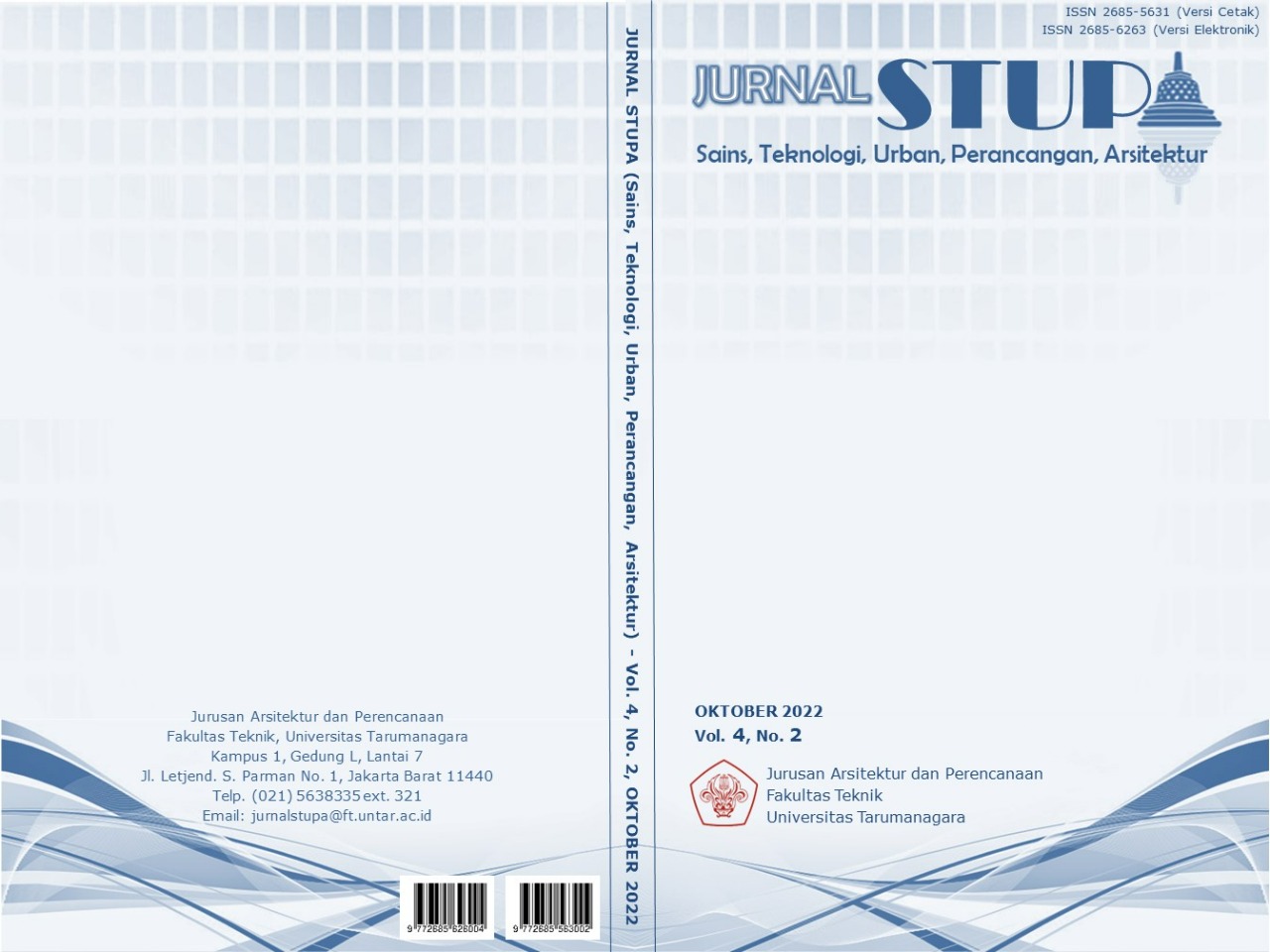PENGOLAHAN RUANG AKTIVITAS WARGA DENGAN METODE PROGRAM DI KOTA BAMBU UTARA
Main Article Content
Abstract
North Kota Bambu required a good planning, an environment also influences the behaviour of the people in it. However, often an environment is porrly plannedm resulting in an environment with a building density that is too high, resulting in lacks quality Urban Open Public Space, one of which is North Kota Bambu. Meanwhile, the existence of open space is needed to meet the needs of the surrounding community, as one of the essential needs that accomodates and provides for the needs and tendecies of existing activities in an evironment. North Kota Bambu has a density level that is too dense, resulting in an unhealthy environment. The existence of openness, triggers a healthy environment. To achieve this, the research method used is qualitative data collection and literature study related to the criteria for a healthy environment and the factors that affect the quality of an environment, and the importance of openness to the environment. For the design method, the program method will be used, which is a method that looks at the tendency of the need for related problems and creates an appropriate program as a form of solving related problem. The result of this study are in the form of design that can blend in with the environment of North Kota Bambu, the formation of open spaces, and the formation of program that can help improve the quality of life by looking at the trend of activities of the people of North kota Bambu. The result of this study are expected to be a solution to the problem of the lack of open space which plays a role in the low quality of life in North Kota Bambu.
Keywords: Density; Environment; Oppenness; Public Space; Quality
Abstrak
Kota Bambu Utara membutuhkan perencanaan yang baik, suatu lingkungan turut memengaruhi perilaku masyarakat didalamnya. Tetapi, seringkali suatu lingkungan direncanakan dengan tidak baik, menghasilkan lingkungan dengan kepadatan bangunan yang terlalu tinggi sehingga kekurangan Urban Open Public Space yang berkualitas, salah satunya Kota Bambu Utara. Adanya ruang terbuka sangatlah dibutuhkan untuk memenuhi kebutuhan masyarakat sekitar, sebagai salah satu kebutuhan esensial yang menampung dan menyediakan kebutuhan dan kecenderungan aktivitas yang ada pada suatu lingkungan. Adanya keterbukaan, memicu terjadinya lingkungan yang sehat. Untuk mencapai hal tersebut, maka metode penelitian yang digunakan adalah pengumpulan data secara kualitatif dan studi literatur terkait dengan kriteria lingkungan yang sehat serta faktor - faktor yang memengaruhi kualitas hidup dan kesehatan suatu lingkungan, dan pentingnya keterbukaan pada lingkungan . Untuk metode desain akan menggunakan metode program, yaitu metode yang melihat akan kecenderungan akan kebutuhan permasalahan terkait dan memunculkan program yang sesuai sebagai bentuk penyelesaian akan permasalahan terkait. Hasil dari penelitian ini berupa desain bangunan yang dapat berbaur dengan lingkungan Kota Bambu Utara, pembentukan ruang terbuka, serta pembentukan program yang dapat membantu meningkatkan kualitas hidup dengan melihat kecenderungan aktivitas masyarakat Kota Bambu Utara. Hasil dari penelitian ini diharapkan menjadi solusi atas permasalahan kurangnya ruang terbuka yang berperan dalam rendahnya kualitas hidup di Kota Bambu Utara.
Article Details

This work is licensed under a Creative Commons Attribution-NonCommercial-ShareAlike 4.0 International License.
This work is licensed under a Jurnal Sains, Teknologi, Urban, Perancangan, Arsitektur/ STUPA Creative Commons Attribution-NonCommercial-ShareAlike 4.0 International LicenseReferences
Astuti, S. Adaptation Behaviour of Residents Living in a High Density Housing in Jakarta. Jakarta : Program Studi Arsitektur. Universitas Persada Indonesia
Ayoub, L., Kobayashi, H. (2001). The Concept of Openness In The Architectural Context. Journal of Architectural Institute of Japan, No. 546, 305 - 313.
Bayramoglu, K., Duzenli, T. (2010). Needs And Preferences of Adolescents In Urban Open Spaces.
Bertaud, A. (2004). The Spatial Organization of Cities : Deliberate Outcome of Unforseen Consequence?. Institute of Urban and Regional Developement University of California at Berkeley. 2 - 33.
Iossifova, D. (2017). Architecture and Urban Design: Leaving behind the notion of the city. In Defining the Urban: Interdisciplinary and professional perspectives, eds. D. Iossifova, C. N. H. Doll & A. Gasparatos, 109-127. London: Routledge
Kapur, R. (2020. Understanding Physical and Environmental Barriers within the Course of Communication. University of Delhi.
Kay, T. (2009). Developing through sport: Evidencing sport impacts on young people
Martineli, P (2019), House, Street, City: Le Corbusier’s Research Towards a New Urban Interior. ISSN 2615-3386 (Online). ISSN 2614-6584 (Print). 2(2), 129 - 153. USA. Miami University.
Memarian, A. Niazkar, N. (2014). The Lost Space of Architecture in the Context of Urban Lost Space. ISSN 2249-8958. International Journal of Engineering and Advanced Technology (IJEAT). 3(5). 1- 11.
Nasution,A, Zahrah, W. (2016). Public Open Space as Urban Architecture: Design and Public Life. Fakultas Teknik. Program Studi Arsitektur. Medan. Universitas Sumatera Utara, 12-18.
Ompad, D. Galea, S. Vlahov, D. Urbanicity, Urbanization, and The Urban Environment. Chapter 3: Urbanicity, Urbanzation, and The Urban Environment. 53 - 66.
Setiowati, R. Hasibuan, H. Koestoer, R. (2018). Green open space masterplan at Jakarta Capital City, Indonesia for climate change mitigation. 1 - 9.
Singh, N. Dubey, A.(2017). Enviromental Density and Its Effect on Health and Quality of Life. ISSN 2249-2496. International Journal of Research in Social Sciences. 7(1). 163 - 173.
W. Sh. Al-Hinkawi. (2002). Urban Acupuncture, a Strategy for Developement : Case Study of Al-Rusafa, Baghdad.
http://encyclopedia.jakarta-tourism.go.id/post/Palmerah-Kecamatan, diunduh pada 13 Agustus 2022.
https://jakbarkota.bps.go.id/publication/2019/09/26//kecamatan-palmerah-dalam-angka-2019, diunduh pada 13 Agustus 2022.



